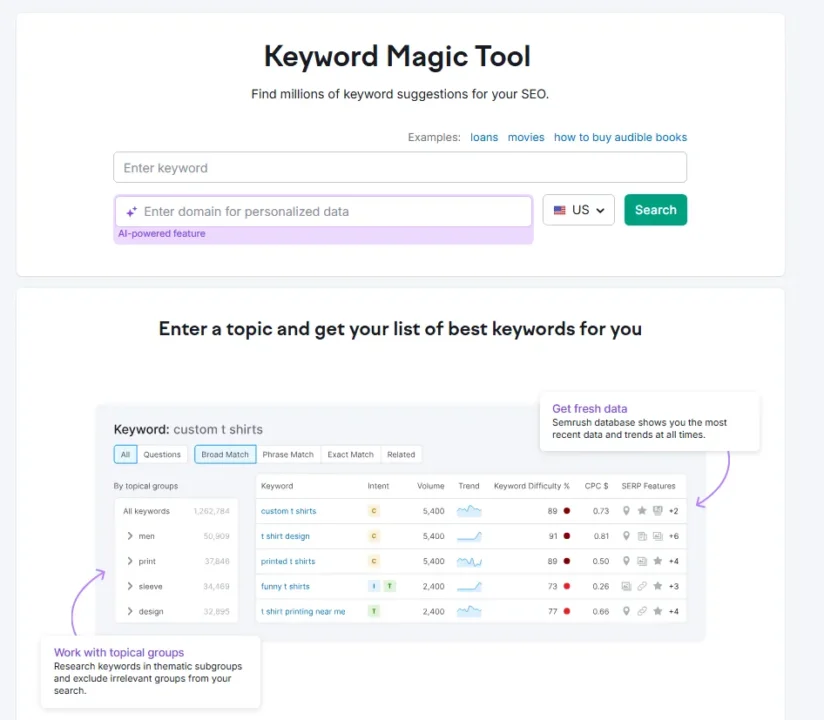Table of Contents
What are Long Tail Keywords?
Long tail keywords contain more than 3 words and also have lower search volume and low keyword difficulty. For example, “Table” is a short tail keyword, while “office table in wood quality” would be a long tail keyword. However, higher purchase intent makes them incredibly valuable for businesses looking to attract qualified leads.
Why Use Long Tail Keywords?
While short-tail keywords have higher search volume, long-tail keywords offer several advantages:
- Lower Competition: Easier to rank for, helping your website stand out.
- Higher Conversion Rate: Users searching for specifics are closer to buying.
- Targeted Traffic: Attract users genuinely interested in your product/service.
How to Use Long-Tail Keywords Effectively
Effectively utilizing long tail keywords requires a strategic approach. Start by conducting thorough keyword research to uncover the most relevant and profitable long tail keywords for your business. Tools like:
Google Keyword Planner (https://ads.google.com/home/tools/keyword-planner/),
SEMrush (https://www.semrush.com/), and

Ahrefs (https://ahrefs.com/) can be invaluable in this process.
Once you’ve identified your target long tail keywords, it’s time to optimize your content. Incorporate these keywords naturally throughout your web pages, blog posts, and other digital assets. Your content should provide value and fulfill the needs and queries of your target audience.
Long Tail Keyword Research Tools
In addition to the previously mentioned some of best keywords research tools, there are several other resources that can help you uncover valuable long tail keywords. These include:
- Answer the Public (https://answerthepublic.com/) – Uncovers question-based long tail keywords
- Ubersuggest (https://neilpatel.com/ubersuggest/) – Provides keyword suggestions and competition data
- KeywordTool.io (https://keywordtool.io/) – Generates long tail keyword ideas based on your seed keywords
Long-Tail Keywords vs. Short Tail Keywords
| Short Tail Keywords | Long Tail Keywords | |
| Characteristics | Broad, general terms High search volume High competition Often used by users in the initial stages of their research | Specific, niche terms Lower search volume Lower competition Often used by users with a clear intent and closer to the purchase stage |
| Examples | “digital marketing” “SEO” “social media” | “Top digital marketing tools for new businesses” “how to improve SEO for e-commerce websites” “social media marketing strategies for B2B companies” |
Optimizing Content for Long Tail Keywords
When optimizing your content for long-tail keywords, focus on creating detailed, informative, and engaging pieces that address the specific needs of your target audience. This could include in-depth blog posts, comprehensive product descriptions, or detailed how-to guides. Remember to use your long-tail keywords naturally throughout the content without sacrificing readability or user experience.
Example 1: E-commerce Store Selling Hiking Gear
- Head Keyword: Hiking Gear
- Long-tail Keywords:
- best hiking boots for women over 50
- lightweight backpacking tent for solo hikers
- waterproof hiking jacket for men under $100
- how to choose the right hiking backpack
Example 2: Health and Wellness Blog
- Head Keyword: Healthy Eating
- Long-tail Keywords:
- healthy meal prep ideas for busy professionals
- best plant-based protein sources for weight loss
- how to make a green smoothie for beginners
- gluten-free and dairy-free dinner recipes
Examples of Long Tail Keywords
Examples for Long-Tail Keywords are given below:
- “best women’s running shoes for high arches”
- “how to start a blog and make money in 2024”
- “top 10 digital marketing strategies for small businesses”
- “organic SEO tips to improve Google rankings”
Effective Strategies for Long-Tail Keywords
To get the most out of your long tail keyword strategy, consider the following tactics:
- Create content clusters around your long tail keywords to build topical relevance.
- Leverage long-tail keywords in your internal linking structure to guide users through your website.
- Optimize following:
meta titles, descriptions, & header tags.
- Monitor keyword performance and adjust strategy.
Content Marketing with Long Tail Keywords
Incorporating long tail keywords into your content marketing strategy can be a powerful way to attract and engage your target audience. By creating informative, valuable content that addresses the specific needs and queries of your customers, you can establish your brand as a trusted authority in your industry.
How to Rank for Long Tail Keywords
Ranking for long tail keywords requires a multi-faceted approach. In addition to optimizing your content for these specific queries, you’ll also need to focus on building high-quality backlinks, improving your website’s technical SEO, and ensuring a positive user experience.
Building a Strategy Around Long-Tail Keywords

Developing a comprehensive SEO strategy that revolves around long tail keywords can be a game-changer for your business. By combining these targeted queries with broader, high-volume keywords, you can create a well-rounded approach that attracts a diverse range of users and drives sustainable growth.
The Role of Long-Tail Keywords in Google Rankings
Google’s algorithm is constantly evolving, but one thing remains clear: long-tail keywords continue to play a crucial role in determining search engine rankings. By targeting these specific, user-intent-driven queries, you can demonstrate your website’s relevance and authority, ultimately improving your visibility in the SERPs.
Conclusion
Long tail keywords are a powerful tool in the world of SEO and digital marketing. By leveraging these targeted, low-competition queries, you can attract highly qualified traffic, drive more conversions, and ultimately dominate the search results. I hope these tips and insights have inspired you to incorporate long-tail keywords into your own marketing strategy. Happy optimizing!
FAQs About Long-Tail Keywords
1. What are long tail keywords?
Long-tail keywords are specific, rich with specific info, lower search-volumes compared to short tail keywords. These queries often have higher purchase intent, making them ideal for attracting qualified leads.
Example:
- Short tail keyword: shoes
- Long tail keyword: men’s leather dress shoes size 10
2. Why are long-tail keywords important?
Long tail keywords offer several advantages over short tail keywords:
- Lower Competition: Easier to rank for in search results.
- Higher Conversion Rates: Specific terms are often closer to making a purchase.
- Targeted Traffic: They attract users genuinely interested in your products or services.
3. How can I find long tail keywords?
You can use various tools for researching long tail keywords:
- Google Keyword Planner: Analyze keywords search volumes & trends.
- SEMrush: Discover competitive insights and keyword opportunities.
- Ahrefs: Identify related keywords and ranking data.
Other helpful tools include: - Answer the Public: Generates question-based keyword suggestions.
- Ubersuggest: Offers keyword ideas and competition analysis.
- KeywordTool.io: Provides extensive long-tail keyword suggestions.
4. How do long-tail keywords differ from short tail keywords?
| Short Tail Keywords | Long-Tail Keywords |
| Broad, general terms | Specific, niche terms |
| High search volume | Lower search volume |
| High competition | Lower competition |
| Used in initial research stages | Used by users with clear purchasing intent |
Examples:
- Short tail: digital marketing
- Long tail: best digital marketing tools for small businesses
5. How do I optimize content for long-tail keywords?
- Research Thoroughly: Identify relevant keywords using keyword research tools.
- Natural Integration: Use keywords naturally in your content without overloading.
- Value-Focused Content: Create detailed, informative, and engaging pieces that address specific user needs. Examples include blog posts, how-to guides, and product descriptions.

